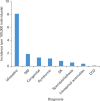Incidence of spinal deformity surgery in a national health service from 2005 to 2018: an analysis of 2,205 children and adolescents
- PMID: 33215103
- PMCID: PMC7659651
- DOI: 10.1302/2633-1462.13.BJO-2020-0001.R1
Incidence of spinal deformity surgery in a national health service from 2005 to 2018: an analysis of 2,205 children and adolescents
Abstract
Aims: Severe spinal deformity in growing patients often requires surgical management. We describe the incidence of spinal deformity surgery in a National Health Service.
Methods: Descriptive study of prospectively collected data. Clinical data of all patients undergoing surgery for spinal deformity between 2005 and 2018 was collected, compared to the demographics of the national population, and analyzed by underlying aetiology.
Results: Our cohort comprised 2,205 patients; this represents an incidence of 14 per 100,000 individuals among the national population aged between zero and 18 years. There was an increase in mean annual incidence of spinal deformity surgery across the study period from 9.6 (7.2 to 11.7) per 100,000 individuals in 2005 to 2008, to 17.9 (16.1 to 21.5) per 100,000 individuals in 2015 to 2018 (p = 0.001). The most common cause of spinal deformity was idiopathic scoliosis accounting for 56.7% of patients. There was an increase in mean incidence of surgery for adolescent idiopathic scoliosis (AIS) (from 4.4 (3.1 to 5.9) to 9.8 (9.1 to 10.8) per 100,000 individuals; p < 0.001), juvenile idiopathic scoliosis (JIS) (from 0.2 (0.1 to 0.4) to one (0.5 to 1.3) per 100,000 individuals; p = 0.009), syndromic scoliosis (from 0.7 (0.3 to 0.9) to 1.7 (1.2 to 2.4) per 100,000 individuals; p = 0.044), Scheuermann's kyphosis (SK) (from 0.2 (0 to 0.7) to 1.2 (1.1 to 1.3) per 100,000 individuals; p = 0.001), and scoliosis with intraspinal abnormalities (from 0.04 (0 to 0.08) to 0.6 (0.5 to 0.8) per 100,000 individuals; p = 0.008) across the study period. There was an increase in mean number of posterior spinal fusions performed each year from mean 84.5 (51 to 108) in 2005 to 2008 to 182.5 (170 to 210) in 2015 to 2018 (p < 0.001) and a reduction in mean number of growing rod procedures from 45.5 (18 to 66) in 2005 to 2008 to 16.8 (11 to 24) in 2015 to 2018 (p = 0.046).
Conclusion: The incidence of patients with spinal deformity undergoing surgery increased from 2005 to 2018. This was largely attributable to an increase in surgical patients with adolescent idiopathic scoliosis. Paediatric spinal deformity was increasingly treated by posterior spinal fusion, coinciding with a decrease in the number of growing rod procedures. These results can be used to plan paediatric spinal deformity services but also evaluate preventative strategies and research, including population screening.
Keywords: Adolescents; Children; Epidemiology; Incidence; Scoliosis; Spinal deformity; Surgery.
© 2020 Author(s) et al.
Conflict of interest statement
ICMJE COI statement: No grants or external funding was received by the authors to support research and preparation of this manuscript. No payments or other benefits nor any commitment or agreement to provide such benefits were received from a commercial entity. Neither payment or direction, nor agreement for payment or direction, of any benefits to any research fund, foundation, educational institution or other charitable or non-profit organization with which the authors are affiliated or associated were received from any commercial entity.
Figures






References
-
- Grivas TB, Koukos K, Koukou UI, Maziotou C, Polyzois BD. The incidence of idiopathic scoliosis in Greece-analysis of domestic school screening programs. Stud Health Technol Inform. 2002;91:71-75. - PubMed
-
- Altaf F, Gibson A, Dannawi Z, Noordeen H. Adolescent idiopathic scoliosis. BMJ. 2013;346:f2508. - PubMed
-
- Liu SL, Huang DS. Scoliosis in China. A general review. Clin Orthop Relat Res. 1996;323:113-118. - PubMed

